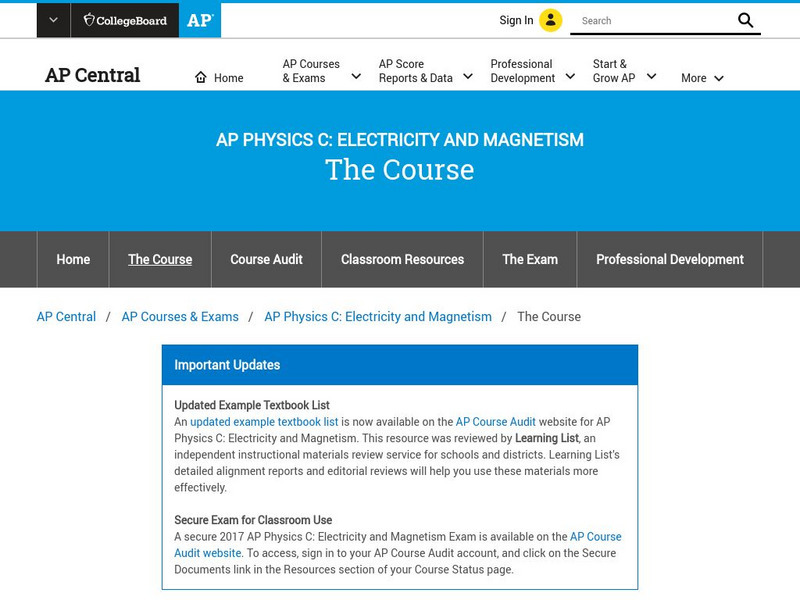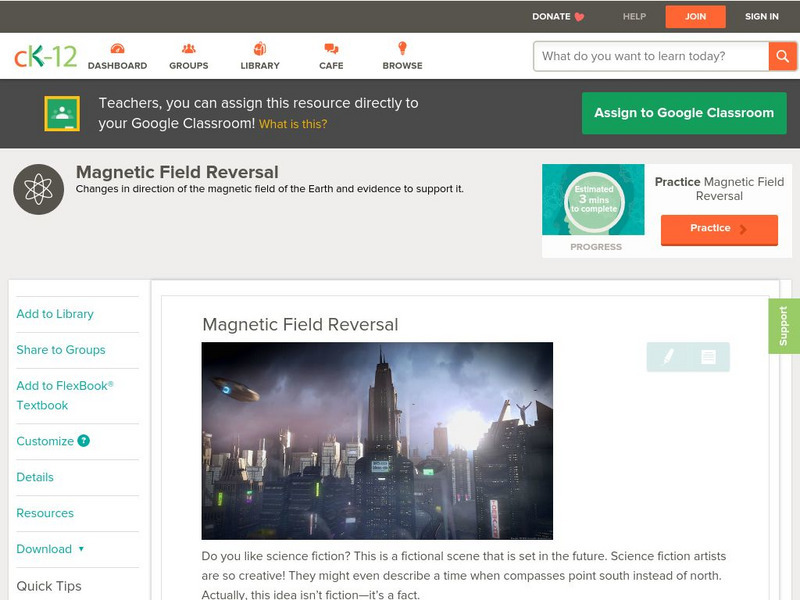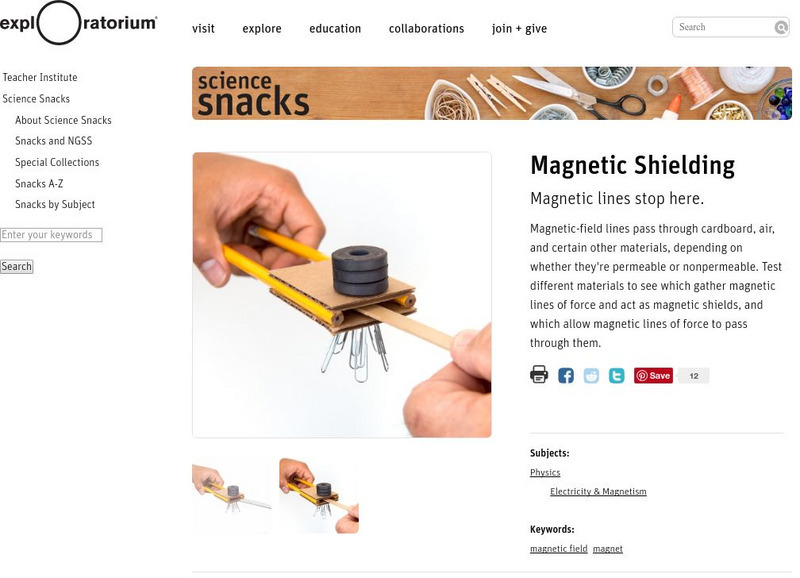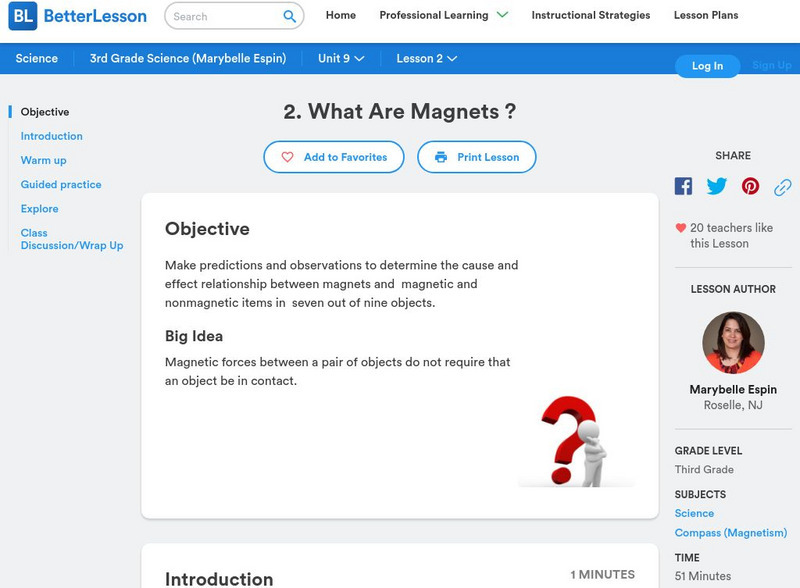Hi, what do you want to do?
National High Magnetic Field Laboratory
Magnet Academy: Magnets From Mini to Mighty
If your knowledge of magnets ends with posting a to-do list on the fridge, add this to the list. Learn more about magnets! You can start here with a straightforward rundown of magnet types, uses and strengths, explained in a way that...
National High Magnetic Field Laboratory
Magnet Academy: Mri: A Guided Tour
Now that MRIs have been around for a few decades, patients and doctors tend to take them for granted. But these awesome diagnostic tools, powered by strong superconducting magnets, save countless lives with their ability to pinpoint...
University of Colorado
University of Colorado: Ph Et Interactive Simulations: Simplified Mri
Explore Magnetic Resonance Imaging, and find out how an MRI can see inside the body.
University Corporation for Atmospheric Research
Ucar: Planet Magnet
Learners use iron filings to explore the magnetic field around a magnet and record their observations then apply their experience with the magnet to understand the magnetic field around Earth.
Science Buddies
Science Buddies: Rock On! Recording Digital Data With Magnets
This is a straightforward project that shows you how data can be digitized and stored on magnetic recording media. You'll learn how alpha-numeric characters are digitized, and you'll use bar magnets to represent the individual data...
National High Magnetic Field Laboratory
Magnet Academy: Richard Feynman
Theoretical physicist Richard Phillips Feynman greatly simplified the way in which the interactions of particles could be described through his introduction of the diagrams that now bear his name (Feynman diagrams) and was a co-recipient...
The College Board
Ap Central: Ap Physics C: Electricity and Magnetism: The Course
CollegeBoard offers a page of resources for students and teachers of AP Physics C: Electricity and Magnetism. Find course and exam information, teaching resources, articles, and recommended links.
Exploratorium
Exploratorium: Science Snacks: Physics/electricity & Magnetism
Exploratorium Science Snacks are miniature science exhibits and experiments that can be made with common, inexpensive, easily available materials. These electricity snacks represent a set of devices that you can build and experiment with...
National High Magnetic Field Laboratory
Magnet Academy: Magnetic Field of a Solenoid
You can create a stronger, more concentrated magnetic field by taking wire and forming it into a coil called a solenoid. (Java tutorial)
National High Magnetic Field Laboratory
Magnet Academy: Felix Bloch (1905 1983)
Physicist Felix Bloch developed a non-destructive technique for precisely observing and measuring the magnetic properties of nuclear particles. He called his technique "nuclear induction," but nuclear magnetic resonance (NMR) soon became...
National High Magnetic Field Laboratory
Magnet Academy: Paul Lauterbur
Chemist Paul Lauterbur pioneered the use of nuclear magnetic resonance (NMR) for medical imaging. He developed a technique, now known as magnetic resonance imaging (MRI), in the early 1970s that involves the introduction of gradients in...
Canada Science and Technology Museum
Canada Science and Technology Museum: Background Information for Magnets
What makes a magnet? Learn all about magnets in this Q&A section. Educator resource materials are linked to this site.
National High Magnetic Field Laboratory
Magnet Academy: Carl Friedrich Gauss
Although he is best known as one of the greatest mathematicians of all time, Carl Friedrich Gauss was also a pioneer in the study of magnetism and electricity. To facilitate an extensive survey of terrestrial magnetism, he invented an...
CK-12 Foundation
Ck 12: Physical Science: Magnetic Field Reversal
[Free Registration/Login may be required to access all resource tools.] Discusses what a magnetic field reversal is and the evidence that this has happened with the Earth.
National High Magnetic Field Laboratory
Magnet Academy: Emf in Inductors
Electromotive Force (EMF) and its sidekick, back EMF, are interesting electromagnetic phenomena that aren't really forces at all. (Java tutorial)
National High Magnetic Field Laboratory
Magnet Academy: Hall Effect
When a magnetic field is applied perpendicular to the flow of current, the field causes resistance in the current. This is the Lorentz force at work, and can be observed well in the Hall effect. (Java tutorial)
Exploratorium
Exploratorium: Science Snacks: Magnetic Shielding
An activity where students test different materials to see which allow magnetic lines of force to pass through them and which block the magnetic lines of force.
University of Colorado
University of Colorado: Ph Et Interactive Simulations: Ph Et: Interactive Simulation: Magnets and Electromagnets
Move a bar magnet or an electromagnet around to see how the magnetic fields change. Requires Java.
Exploratorium
Exploratorium: Science Snacks: Magnetic Pendulums
See how electricity and magnetism interact with this activity. Activity has students creating a current by swinging a copper coil through a magnetic field. The copper coil will start a second coil swinging as well.
Better Lesson
Better Lesson: 2. What Are Magnets ?
Make predictions and observations to determine the cause and effect relationship between magnets and magnetic and nonmagnetic items in seven out of nine objects.
Florida State University
Florida State University: Magnet Lab: Discovery of Electromagnetism
Two scientists share the credit for discovering, and then interpreting, the phenomenon of electromagnetism.
ArtsNow
Arts Now Learning: Magnetic Pollack [Pdf]
In this lesson, 5th graders will create a painting based on the action paintings by Jackson Pollock. Instead of dripping and splattering, the paint will be moved using a metal object, such as a paper clip, along with a magnet.
NASA
Nasa: Magnetic Fields
This site from NASA provides a short, illustrated description of the basics of magnetic fields and magnetic poles.

























